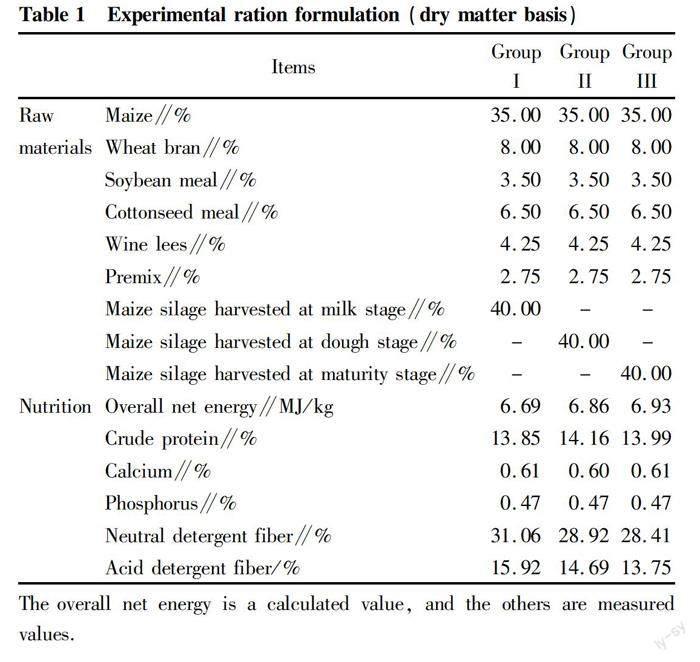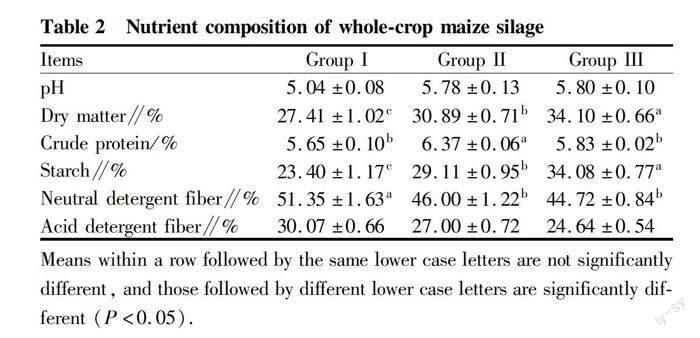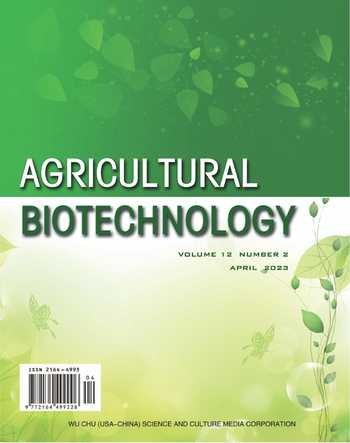Effects of Maize Silage Harvest Stage on Growth Performance and Economic Benefits of Beef Cattle
Shuo YANG, Miaoyi ZHANG, Yancheng ZHOU, Huihui LIU, Yuping LIU, Yuqi LIU, Boyang LI, Yi LI, Mingjie YIN, Xiaoliang PEI



Abstract [Objectives] This study aimed to investigate the effects of whole-crop maize silage harvested at different stages on growth and economic benefits of beef cattle.
[Methods] A total of 30 Simmental crossbred cattle weighing about 378 kg were randomly divided into three groups, respectively fed for 70 days with whole-crop maize silage harvested at milk stage (Group I), dough stage (Group II) and physiological maturity stage (Group III). Moreover, the cattle in all groups were given the same concentrate diet.
[Results] There were significant differences in dry matter, crude protein and neutral detergent fiber between whole-crop maize silages harvested at different stages (P<0.05). The dry matter in Group II and III was significantly higher than that in Group I (P<0.05). The crude protein content peaked in Group II, up to 6.37%, which was significantly higher than that in Group I (by 12.74%, P<0.05) and Group III (by 9.26%, P<0.05). Starch content significantly increased with the postponing of maize harvest (P<0.05). The content of neutral detergent fiber in Group I was significantly higher than that in Group II (P<0.05) and Group III (P<0.05). The average daily weight gain in Group II was 8.53% higher than that in Group I (P<0.05) and 3.70% higher than that in Group III (P>0.05). The dry matter intake in Group II was significantly higher than that in Group I (P<0.05) and Group III (P<0.05). There was no significant difference in feed/gain ratio between the groups (P>0.05). The economic benefit in Group II was the highest, up to 9.99 yuan/day per capita., followed by that in Group III, 9.79 yuan/day per capita, and that in Group I was the lowest, only 8.03 yuan/day per capita.
[Conclusions] The whole-crop maize silage harvested at dough stage has the best quality and produces the highest economic returns for beef cattle.
Key words Harvest stage; Whole-crop maize silage; Beef cattle; Growth performance; Economic benefits
Received: January 28, 2023 Accepted: March 29, 2023
Supported by the Fourth Batch of High-end Talent Project in Hebei Province; Hebei Provincial Forage Innovation Team Building from the Earmarked Fund for China Agriculture Research System (HBCT2018160403).
Shuo YANG (1986-), male, P. R. China, master, senior engineer, devoted to the research about quality and safety inspection of agricultural products.
Miaoyi ZHANG (1995-), female, P. R. China, bachelor, junior accountant, devoted to the research about quality and safety inspection of agricultural products.
#The first two authors contributed equally to this work.
*Corresponding authors. Mingjie YIN, E-mail: 894824033@qq.com; Xiaoliang PEI, E-mail: bibexixi@126.com.
Whole-crop maize silage is made from maize plants via microbial fermentation under anaerobic conditions after they are harvested, chopped, compacted and sealed. It has been considered as a high-quality roughage for beef cattle, due to its rich nutrients, good palatability and digestibility[1-2]. The harvest stage of maize silage is the main factor affecting its feeding value, contents of protein and other nutrients[3]. Right amounts of water and sugar and anaerobic environment are indispensable during maize silage fermentation[4]. If the maize plants are harvested too early, nutrients may flow out along with water that come from the high-moisture plants during fermentation. Meanwhile, starch in early-harvested kernels has not completely accumulated, which may lower the energy level of silage[5]. However, if the maize plants are harvested too late, the high level of lignification may cause loss of nutrients and poor silage quality[6]. Therefore, the present study was carried out to reveal the effects of whole-crop maize silage harvested at milk, dough and maturity stage on weight gain and economic benefits of beef cattle, and to determine the optimal harvest stage of maize silage.
Materials and Methods
Experimental design
Thirty Simmental crossbred cattle with similar age, fat and weight (378 kg or so) and good body condition were selected and randomly divided into three groups, with 10 in each group, fed with whole-crop maize silage harvested at milk stage (Group I), dough stage (Group II) and physiological maturity stage (Group III). All the cattle were given the same concentrate diet. The trial lasted for 70 days, with the first 10 days of pre-feeding, followed by 60 days of formal feeding.
These cattle were fed twice at 5:30 a.m. and 4:00 p.m. every day, with free access to water. All other feeding and management practices were performed as usual. The composition and nutrients of the experimental rations are shown in Table 1.
Measurement of experimental items
Determination of nutrient composition of whole-crop maize silage
The pH, dry matter, crude protein, starch, neutral detergent fiber and acid detergent fiber contents of whole-crop maize silage harvested at different stages were measured.
Measurement of beef cattle growth performance
Each cow was weighed once at the beginning and once at the end of the formal trial, and the weight of each cow was recorded and daily weight gain was calculated. Feed intake was measured once every 10 days. Feed water content was also measured to calculate dry matter intake and feed/weight ratio.
Economic benefit analysis
The economic cost and income were calculated based on daily feed and daily weight gain of beef cattle, and finally the average economic benefit per day per capita of different groups were compared.
Statistical analysis
One-way ANOVA and Duncans multiple comparisons were performed using SPSS 19.00 software. The data were expressed as "mean±standard deviation", and P<0.05 indicated significant differences.
Results and Analysis
Nutrient composition of whole-crop maize silage harvested at different stages
As shown in Table 2, there was no significant difference (P>0.05) in pH value of whole-crop maize silage harvested at different stages. There was significant difference in dry matter content between the groups, and the dry matter content of Group II and Group III was 12.70% (P<0.05) and 24.41% (P<0.05) higher than that of Group I. The crude protein content in Group II was the highest, up to 6.37%, which was 12.74% higher than that in Group I (P<0.05) and 9.26% higher than that in Group III (P<0.05). Starch content increased with the postponing of harvest stage, showing significant difference between the three groups (P<0.05). The neutral detergent fiber content in Group I was 11.63% higher than that in Group II (P<0.05) and 14.83% higher than that in Group III (P<0.05). There was no significant difference in acidic detergent fiber content between the three groups (P>0.05).
Effects of whole-crop maize silage harvested at different stages on growth performance of beef cattle
As can be seen from Table 3, there was no significant difference in initial weight of beef cattle between the groups (P>0.05). Final weight in Group II was the highest, followed by that in Group III and Group I, but no significant difference was observed between the three groups (P>0.05). The average daily weight gain of Group II was 8.53% higher than that of Group I (P<0.05) and 3.70% higher than that of Group III (P>0.05), and the average daily weight of Group III was 4.65% higher than that of Group I (P<0.05). The dry matter intake of Group II was significantly higher than that of Group I (P<0.05) and Group III (P<0.05), and the difference between groups I and III was not significant (P>0.05). The feed/weight ratio slightly decreased with the postponing of harvest stage, but the difference between the three groups was not significant (P>0.05).
Effects of whole-crop maize silage harvested at different stages on economic benefits of beef cattle
As can be seen from Table 4, the weight gain income in Group II was the highest, up to 35.25 yuan/day per capita, which was 3 and 1.5 yuan more than that in groups I and III, respectively. Among the three experimental groups, the economic benefit in Group II was the highest up to 9.99 yuan/day per capita, followed by 9.79 yuan/day per capita in Group III, and the lowest 8.03 yuan/day per capita in Group I.
Discussion
Nutrition analysis of whole-crop maize silage harvested at different stages
Harvest stage obviously affects the nutrition of whole-crop maize silage. Our findings showed that dry matter and starch content of whole-crop maize silage gradually increased with the postponing of harvest stage, while the contents of neutral detergent fiber and acid detergent fiber gradually decreased, which is consistent with Wangs study[7]. The reason may be that the proportion of maize seeds increases while that of straw decreases over time during maize maturation, resulting in an increase in starch content and a corresponding decrease in fiber content[8]. Secondly, the high moisture content of maize plants harvested at early milk stage may result in nutrient loss during fermentation, and the incomplete accumulation of starch in maize seed kernels may lead to lower energy level in silage[5]. However, maize plants harvested at maturity stage have low moisture content, and are difficult to be well compacted during fermentation, which adversely affects silage quality[9]. With the postponing of harvest stage, the crude protein content of whole-crop maize silage increased at first, peaked at dough stage, and then decreased, which is consistent with previous studies[10]. This may be due to the fact that crude protein is still growing at milk stage and has not reached the maximum level till dough stage. Then, the crude protein begins to lose due to the higher degree of lignification of maize silage harvested at maturity stage[1].
Effects of whole-crop maize silage harvested at different stages on growth performance of beef cattle
The dry matter intake of beef cattle fed with whole-crop maize silage harvested at dough stage in this study was significantly higher than that fed with silage harvested at milk stage and maturity stage, which is in accordance with previous studies[11]. The moisture content and nutrients of maize plants harvested at dough stage result in better silage quality and palatability, while maize plants harvested at milk and maturity stages have too high or too low moisture content, resulting in poor silage quality, which adversely affects silage palatability and reduces dry matter intake by beef cattle. In this experiment, it was found that the dry matter intake of beef cattle was proportional to energy and nutrients they indigested. The dry matter and energy intake by cattle beef fed with whole crop maize silage harvested at dough stage were the highest, followed by those fed with silage harvested at maturity stage, and those fed with silage harvested at milk stage was the lowest. Accordingly, the daily weight gain changed in a similar pattern in these groups.
Effects of whole-crop maize silage harvested at different stages on economic benefits of beef cattle
The present study showed that the cost of whole-crop maize silage harvested at different stages was the same, but the average daily weight gain and income of beef cattle fed with whole-crop maize silage harvested at dough stage were both higher than those in the other two groups, so the economic benefit of this group was the highest.
Conclusions
Harvest stage of whole-crop maize silage greatly affects the growth performance of beef cattle, and the silage harvested at the dough stage has higher nutrition and better palatability, so beef cattle fed with such silage have the highest average daily weight gain and economic benefits.
References
[1] HUANG YQ. Effect of variety and harvest stage on the quality of maize silage[D]. Xianyang: Northwest A & F University, 2018. (in Chinese).
[2] KHAN NA, YU P, ALI M, et al. Nutritive value of maize silage in relation to dairy cow performance and milk quality[J]. Journal of the Science of Food and Agriculture, 2015, 95(2): 238-252.
[3] ZHAGN JW, WANG KJ, HU CH. Effect of harvest stage on nutritive value of maize silage[J]. Journal of Maize Sciences, 2000(S1): 33-35. (in Chinese).
[4] XIA C, LIANG Y, BAI S, et al. Effects of harvest time and added molasses on nutritional content, ensiling characteristics and in vitro degradation of whole crop wheat[J]. Asian-Australas J Anim Sci., 2017, 31(3): 354-362.
[5] WINDLE M C, WALKER N, KUNG L. Effects of an exogenous protease on the fermentation and nutritive value of corn silage harvested at different dry matter contents and ensiled for various lengths of time[J]. Journal of Dairy Science, 2014, 97(5): 3053-3060.
[6] MA BL, SUBEDI KD, STEWART DW, et al. Dry Matter accumulation and silage moisture changes after silking in leafy and dual-purpose corn hybrids[J]. Agronomy Journal, 2006, 98(4): 922-929.
[7] WANG XZ. Effects of firmness and harvest stage on quality and mycotoxins of whole-crop maize silage[D]. Shihezi: Shihezi University, 2019. (in Chinese).
[8] HATEW B, BANNINK A, LAAR HV, et al. Increasing harvest maturity of whole-plant corn silage reduces methane emission of lactating dairy cows[J]. Journal of dairy science, 2016, 99(1): 354-368.
[9] COMINO L TABACCO E, RIGHI F, et al. Effects of an inoculant containing a Lactobacillus buchneri that produces ferulate-esterase on fermentation products, aerobic stability, and fibre digestibility of maize silage harvested at different stages of maturity[J]. Animal Feed Science & Technology, 2014(198): 94-106.
[10] ZENG DB, WANG JM, WU XY, et al. Analysis on the nutritional quality of plant body of silage maize with different varieties and different growth stages[J]. Hubei Agricultural Sciences, 2019, 58(5): 85-87, 95. (in Chinese).
[11] LI YM. Effect of maize silage harvested at different stages on performance and meat quality of beef cattle[J]. Feed China, 2011(12): 27-30. (in Chinese).
- 农业生物技术(英文版)的其它文章
- Improving the Heat Resistance of β-1,4 Glucanase by Introducing Disulfide Bonds
- Comparative Study on Biological and Commercial Characteristics of Mul-tiple Varieties of Broccoli (Brassica oleracea L. var. italica Plenck) and Vegetable Soybean (Glycine max (L.) Merr.)
- Effects of Bamboo Charcoal-based Biochar on Soil Enzyme Activity and Microbial Community Structure
- Summary of Short-vine Watermelon Breeding Practice
- Effects of Combined Application of Biochar-based Organic Fertilizer and Reduced Nitrogen Fertilizer on Soil Enzyme Activity and Yield of Purple Cabbage (Brassica oleracea var. capita rubra)
- Effects of Microelement Fertilizers on Main Economic Characters and Yield of Peanut

